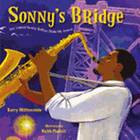
In the 1940s, a young saxophonist named Sonny Rollins began sneaking into Harlem's Apollo Theater and Cotton Club to hear jazz musicians like John "Dizzy" Gillespie and Charlie "Bird" Parker. He began playing "two-bit joints," writing his own music and turning standards like Billie Holliday's "God Bless the Child" into his own. By his 20s, he had rocketed "to the top of the jazz universe." But when he was "twenty-nine in '59, in his prime,/ Sonny shatter[ed] the jazz world" by taking a break from performing and recording. Sonny looked for a private place to play--and found that place on the Williamsburg Bridge.
For more than two years, Sonny found "refuge and sol-i-tude" on the pedestrian walkway of the bridge. When he emerged from his self-imposed exile, he went back into the recording studio and released to acclaim a new album called The Bridge. He had become "more confident in himself as a musician and as a person," Barry Wittenstein (Waiting for Pumpsie) writes in the "Liner Notes" of the book's back matter (which also include an author's note, a timeline of Rollins's life and additional notes and quotes).
Wittenstein's energetic text mimics the syncopated rhythms of jazz, incorporating the lingo and locales of the time. Keith Mallett's (Take a Picture of Me, James VanDerZee) digital illustrations also capture the electric mood of the end of the bebop era. Using warm, vibrant colors, his depictions of Sonny and his cohort are expressive and full of life. Readers accustomed to YouTube superstars will be intrigued by this story of one musician truly "find[ing] his groove" after stepping away from the limelight for an unimaginably long period (in today's terms) of more than two years. --Emilie Coulter, freelance writer and editor

